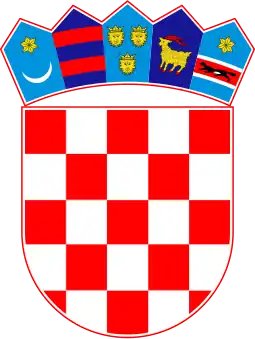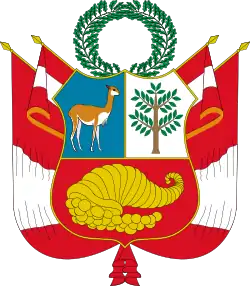 | |
Croatia |
Peru |
|---|---|
Croatia-Peru relations refers to the bilateral relations between Croatia and Peru. Both countries established diplomatic relations on January 12, 1993. Croatia is represented in Peru through its embassy in Santiago and through an honorary consulate in Lima. Peru is represented in Croatia through its embassy in Bucharest and through an honorary consulate in Zagreb.
A large community of people of Croatian descent live in Peru, mostly in Lima, Callao and Cerro de Pasco.[1] Most Croats arrived in Peru between the Interwar period. Over a dozen families of Croatian descent live in Arequipa alone.[2] In Lima, there are over 40 families.[3]
History
20th century
Croatian immigrants to Peru first arrived during the 16th century, arriving from Dalmatia to coastal Peru.[4] On January 7, 1906, the Slavic Charitable Society was founded by local slavs, most of them Croats. Ivan Ostoja was named as president and the Honorary Consul of Austria, Walter Justus, was named as honorary president.[5] In 1911, a dispute arose over which flag to use for the society, which led to some Serbian members leaving the organisation, founding a parallel society the same year that functioned until 1917, when the Serbs again joined the Slavic society after the removal of the portraits of Emperor Franz Joseph I of Austria and his consort due to the nationalist sentiment that arose during World War I.[6]
Relations between Peru and the then Kingdom of Yugoslavia date back to the 1920s,[7] as the latter had established an honorary consulate in Lima and the former had consulates in Belgrade and Zagreb by 1929.[8] The Croat minority in Peru present in the city's capital, Callao and Cerro de Pasco,[9] was represented by the Yugoslav Society in central Lima.[10] During World War II in Yugoslavia, Peru established economic and consular relations with the Yugoslav government-in-exile in October 1942.[11] The honorary consulate in Lima was at the time administered by Croats, while the official consulate and embassy were located in Chile.[12]
After World War II, a new wave of Croats arrived to Peru, with most of them being combatants who fought against the partisan forces of Josep Broz Tito.[13] The earliest arrivals happened in 1948 and 1949 due to the efforts of the International Refugee Organization (IRO) and the cooperation of the government of José Luis Bustamante y Rivero.[14] According to the 1993 Peruvian census, there were 187 persons who identified themselves as Croatian, while 269 did so as Yugoslavs.[4]
In 1969, the Yugoslav Society moved to its current location in the district of Jesús María in Lima. During this time, it became a non-profit society, changing into more of a recreational club. In 1973 it changed its name to Dubrovnik Yugoslav Association, and during the 1990s due to the Yugoslav Wars, changing to its current name, Dubrovnik Croat Association, in 1994.[15] The club acts as the honorary consulate of Croatia in Peru.[16]
Recent history
After the breakup of Yugoslavia, Peru continued relations with the Federal Republic of Yugoslavia (Serbia and Montenegro)[17] but also recognised its successor states, such as Croatia in 1993.[18]
Both countries signed a memorandum of understanding in 2013.[19]
Croatia became a part of the free trade agreement between Peru, Colombia (and later Ecuador) and the European Union in 2015.[20]
See also
References
- ↑ "Un amigo del Peru: Marko Burin, un croata que ama a nuestro país". RPP Noticias. 2009-06-22. Archived from the original on 2010-01-25.
- ↑ Pletickosich 2017, p. 70.
- ↑ Puh 2021, p. 10.
- 1 2 Pletickosich 2017, p. 43.
- ↑ Puh 2021, p. 1.
- ↑ Puh 2021, p. 2.
- ↑ "Serbia: Relaciones Bilaterales". Ministry of Foreign Affairs. Archived from the original on 2009-08-25.
- ↑ Lascano; Lopez (1929). Almanaque Ilustrado del Perú 1929 (in Spanish). Ed. Guia Lascano. p. 100.
- ↑ Burin 2009, p. 85: Conversión de las Sociedades Slavas de Beneficiencia en Sociedades Yugoslavas de Beneficiencia: "Como consecuencia de la creación del Estado de Yugoslavia, las Sociedades Slavas de Beneficiencia que existían tanto en el Callao como en Cerro de Pasco cambiaron su nombre por el de Sociedades Yugoslavas de Beneficencia.
La sociedad que había sido fundada en el Callao en 1906, cambió su nombre en 1922 por el de Sociedad Yugoslava de Beneficencia. Ese mismo año la institución dejó la sede del Callao y se trasladó a Lima. Esto fue por el hecho de que la mayoría de los eslavos residía en la ciudad capital. Paulatinamente, varios de los yugoslavos que antes residían en el interior del país (sobre todo en ciudades de la sierra central) se habían ido trasladando a Lima. Por ejemplo, en 1923 fue elegido Nicolás Lale en el cargo de presidente de la institución, quien había sido uno de los fundadores de la Sociedad de Beneficiencia creada en Cerro de Pasco en 1881." - ↑ Burin 2009, p. 85: "En Lima, la institución tuvo inicialmente una sede en la calle Santo Toribio, en el centro de Lima (cerca de la iglesia de San Francisco); luego se trasladó a la calle San José, donde compartió el local de la empresa del Sr. Mateo Galjuf. En 1942, la institución pasó al local del Jr. Callao, en la esquina con el Jr. Camaná, hasta que se mudó en 1945 a su local propio de la calle San Martín, en el distrito de Magdalena del Mar. En 1968, esta institución se trasladó definitivamente a la Av. San Felipe, distrito de Jesús María, lugar donde funciona hasta la fecha [2009]."
- ↑ Foreign Assistance and Related Agencies Appropriations for 1972: Hearings Before a Subcommittee of the Committee on Appropriations, House of Representatives, Ninety-second Congress, First Session. U.S. Government Printing Office. 1971. p. 841.
- ↑ Burin 2009, p. 85: "Durante este periodo el Consulado yugoslavo estuvo a cargo del croata Antonio Ciurlizza, quien desempeñó el cargo desde 1920 hasta 1947. Como secretario del Consulado estuvo Andrés Puljižević (natural de Dubrovnik), quien durante la Segunda Guerra Mundial dirigió la revista Mundo Slavo que se editaba en Lima. El Consulado en Perú era un cargo honorario, mientras que el Consulado oficial y la Embajada de Yugoslavia estaban en Santiago de Chile.
En el año 1943, vino al Perú el embajador de Yugoslavia Dr. Kolombatović. La sede de la embajada de Yugoslavia estaba en Santiago de Chile. Desde los años posteriores a la Segunda Guerra Mundial, el Perú no tuvo relaciones diplomáticas con Yugoslavia, las que se restablecieron en la década de 1979." - ↑ Puh 2021, p. 6.
- ↑ Pletickosich 2017, p. 40–41.
- ↑ Puh 2021, p. 6, 8.
- ↑ "Obavijest o održavanju konzularnih dana u Limi, Peru". Veleposlanstvo Republike Hrvatske u Santiagu de Chile. 2016-03-10.
- ↑ "SERBIA-PERU [RELATIONS]". Ministry of Foreign Affairs. Archived from the original on 2012-03-05.
- ↑ "Collection of International Treaties: Peru". Ministry of Foreign Affairs. Archived from the original on 2011-09-28.
- ↑ "Croatia, Peru sign Memorandum of Agreement". Ministry of Foreign and European Affairs. 2013-06-10.
- ↑ "Croatia to formally become part of the EU-Colombia/Peru Trade Agreement" (PDF). Directorate General for Trade. European Commission. 2015-06-30.
Bibliography
- Burin, Marko (2009). La familia croata en el Peru (in Spanish). Marko Burin.
- Pletickosich López, Jianphier (2017). La inmigración croata a Arequipa, siglo XX (Thesis) (in Spanish). Arequipa: Universidad Católica de San Pablo.
- Puh Ponce, Pedro. "BREVE RESEÑA HISTÓRICA". Asociación Croata Dubrovnik.

